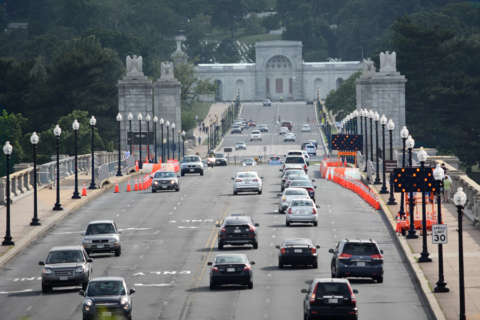WASHINGTON — One of D.C.’s most iconic but aging structures — the Arlington Memorial Bridge — will soon undergo a major overhaul.
The National Park Service is advising everyone who uses the bridge to expect some inconveniences starting after Memorial Day.
In the weeks ahead there will be lane closures that could cause traffic to slow on the George Washington Parkway at Memorial Circle, according to the National Park Service.
Even pedestrians and cyclists on Mount Vernon Trail could be occasionally be delayed.
“We’re strengthening the road surface and the road support structure of Arlington Memorial Bridge so that we can bring the construction equipment on to the bridge for the full rehabilitation,” said Aaron LaRocca, a park ranger with the National Park Service.
Up to two lanes and one sidewalk on the bridge will be temporarily closed as work crews pour concrete and establish staging areas for heavy equipment.
“These immediate repairs are needed to facilitate the larger, full rehabilitation of Arlington Memorial Bridge, which is scheduled to start in the fall of 2018,” LaRocca said.
Part of the bridge’s planned $227 million overhaul will involve removing inoperable drawbridge hardware beneath the bridge’s center.
The bridge served as a drawbridge in the early decades following its construction that was completed in 1931, but drawbridge operations ended in the 1960s.
LaRocca said much of the summer work will be scheduled during weekends and off hours to reduce traffic disruptions.
“The goal is to maintain as much access as possible on the roadway and on the sidewalk while maintaining bridge safety,” LaRocca said.
The neoclassical steel and stone arch structure is no ordinary bridge.
Symbolically, it’s meant to show the unity of the nation by linking the Lincoln Memorial with Arlington House, the Robert E. Lee Memorial.
The bridge — a gateway to Arlington National Cemetery also memorializes the sacrifices and valor of the nation’s military.
“We’re not only maintaining this critical commuter corridor, we’re also rehabilitating a piece of our culture, a piece of our history,” LaRocca said.
The nearly 90-year-old bridge accommodates about 68,000 daily vehicle crossings and the National Park Service said the rehabilitation when completed in the fall of 2021 will ensure the bridge’s safety for at least another 75 years.









